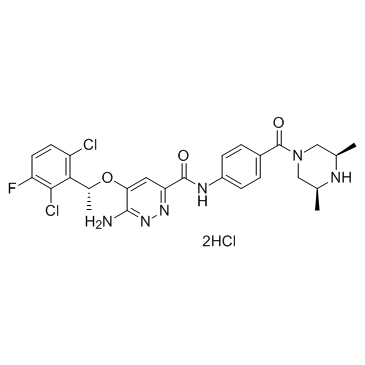X-396 hydrochloride
Modify Date: 2025-08-25 15:57:05

X-396 hydrochloride structure
|
Common Name | X-396 hydrochloride | ||
|---|---|---|---|---|
| CAS Number | 2137030-98-7 | Molecular Weight | 634.36 | |
| Density | N/A | Boiling Point | N/A | |
| Molecular Formula | C26H29Cl4FN6O3 | Melting Point | N/A | |
| MSDS | N/A | Flash Point | N/A | |
Use of X-396 hydrochlorideEnsartinib hydrochloride (X-396 hydrochloride) is a potent and dual ALK/MET inhibitor with IC50s of <0.4 nM and 0.74 nM, respectively. |
| Name | X-396 hydrochloride |
|---|
| Description | Ensartinib hydrochloride (X-396 hydrochloride) is a potent and dual ALK/MET inhibitor with IC50s of <0.4 nM and 0.74 nM, respectively. |
|---|---|
| Related Catalog | |
| Target |
IC50: <0.4 nM (ALK), 0.74 nM (MET)[1] |
| In Vitro | Ensartinib (X-396) is a potent and dual ALK/MET inhibitor with IC50s of <0.4 nM and 0.74 nM, respectively. Ensartinib is potent in H3122 lung cancer cells harboring EML4-ALK E13;A20 (IC50: 15 nM). Ensartinib is also potent in H2228 lung cancer cells harboring EML4-ALK E6a/b; A20 (IC50: 45 nM). Furthermore, X-376 is potent in SUDHL-1 lymphoma cells harboring NPM-ALK (IC50: 9 nM)[1]. |
| In Vivo | Ensartinib (X-396) shows substantial bioavailability and moderate half-lives in vivo. Nude mice harboring H3122 xenografts are treated with Ensartinib at 25 mg/kg bid. Ensartinib significantly delays the growth of tumors compared to vehicle alone. In the xenograft experiments, Ensartinib appears well-tolerated in vivo. Mouse weight is unaffected by Ensartinib treatment. Drug-treated mice appear healthy and do not display any signs of compound related toxicity. To further assess potential side effects of Ensartinib, additional systemic toxicity and toxico-kinetic studies are performed in Sprague Dawley (SD) rats. Following 10 days of repeated oral administration of Ensartinib at 20, 40, 80 mg/kg in SD rats, all animals survive to study termination. The no significant toxicity (NST) levels are determined to be 80 mg/kg for Ensartinib. At NST levels, Ensartinib achieves an AUC of 66 μM×hr and a Cmax of 7.19 μM[1]. |
| Cell Assay | For viability experiments, cells are seeded in 96-well plates at 25%-33% confluency and exposed to drugs. The human lung adenocarcinoma cell lines H3122 and H2228 are treated with Ensartinib (10, 30, 100, 300 and 1000 nM). SUDHL-1 lymphoma cells are treated with Ensartinib (5, 10, 30, 100 and 300 nM). SY5Y neuroblastoma cells are treated with Ensartinib (30, 100, 300 and 1000 nM). At 72 hours post Ensartinib addition, Cell Titer Blue Reagent is added and fluorescence is measured on a Spectramax spectrophotometer. All experimental points are set up in hextuplicate replicates and are performed at least two independent times. IC50s are calculated using GraphPad Prism version 5 for Windows. The curves are fit using a nonlinear regression model with a log (inhibitor) vs. response formula[1]. |
| Animal Admin | Mice[1] Nude mice (nu/nu) are injected with H3122 cells. Once tumors reach an average volume of 450 mm3, a total of 27 athymic mice harboring H3122 tumors are randomized and dosed via oral gavage with 25 mg/kg Ensartinib or the control vehicle. Two, five, and fifteen hours after the single treatment (3 tumors/timepoint/group), mice are sacrificed and serum is collected for assessment of drug concentration using an LC-MS based bioanalytical method[1]. |
| References |
| Molecular Formula | C26H29Cl4FN6O3 |
|---|---|
| Molecular Weight | 634.36 |